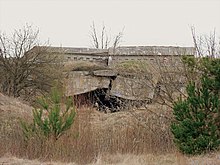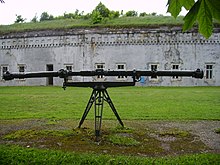Osowiec fortress
The fortress Osowiec ( Polish Twierdza Osowiec , Russian Крепость Осовец , German formerly fortress Ossowitz ) in northeastern Poland was built by the Russian army in the 19th century . It was in the Grodno governorate of the Russian Empire .
Location and military importance
On the orders of Tsar Alexander II , with the help of Nestor Buinitsky, more than 1,000 hectares of land near the village of Osowiec were acquired on the bank of the Biebrza (also known as Belarus or Ukrainian Bobr or Bober) and the residents were forcibly relocated. The Osowiec fortress was built during the reign of the subsequent Tsar Alexander III. Erected according to a design from 1873. Initially three forts were built, which were later supplemented by a fourth.
When completed, the fortress consisted of four forts connected by ramparts and moats. The fortifications were initially built as brick masonry, but the fourth fort was already built using concrete. It was the first fortification of its kind in the tsarist empire.
Immediately after completion, the Osowiec fortress was further modernized until 1892. After the Russo-Japanese War in 1904/05, further measures were taken to modernize and strengthen it. At the beginning of the First World War , the fortress was provided with 69 stationary guns. In addition, the crew had 24 mobile field guns available.
The fortress Osowiec was 50 kilometers from the border with East Prussia on one of the most important crossings over the river Biebrza. It was surrounded by the swamps of the same name. The railway line ran through the fortress from Białystok via Lyck to Koenigsberg and was completely ruled by it at this point. Its location on both sides of the river, surrounded by swamps, characterized the fortress, making it difficult to reach and hardly vulnerable. The military leadership of Russia considered it impregnable. Nevertheless, it was attacked several times by strong German forces in the first year of the World War.
The ruins of the fortress can be partially visited today, which takes about a day. A museum is set up. A small part of the fortress was still used for military purposes until recently.
Osowiec Fortress is now in the area of the Biebrzański National Park .
Fight for the fortress in World War I
Siege in September 1914
In September 1914, after the Battle of the Masurian Lakes , parts of the German 8th Army approached the Osowiec fortress. By September 21, 1914, the German troops had pushed their Russian opponents back so far that the fortress came within range of their artillery. From September 26, 1914, heavy artillery with a gun caliber of up to 210 mm was also used. A total of 60 guns directed their fire on the fortress. After two days, the Germans dared an attack by their infantry on the fortress, which failed in the fire of the defenders and their fortress guns. The next day the Russians counterattacked. In a pincer movement, they forced the Germans to withdraw their guns.
Siege in the spring of 1915
On February 3, 1915, the German troops attacked the fortress again. The attack took place in connection with the general offensive of the German armies on the East Prussian section of the Eastern Front , which led to the winter battle in Masuria . There was fierce fighting with a first defensive ring around the fort, which the Russians had built. After five days, on February 9, 1915, the Russians withdrew to a second prepared defensive ring, whose dug trenches and machine gun nests they protected and they successfully withstood. However, because of the shorter distance, the Germans were now able to shoot at the fortress directly. They brought 68 guns into position. The fortress suffered the heaviest bombardment from February 14 to 16, 1915 and from February 25 to March 5, 1915. The German air forces also supported the siege and dropped bombs on the fortress.
Osowiec Fortress suffered badly from the bombardment. Fires broke out and buildings collapsed. Finally, no connection between the forts was possible. However, since the Russian defensive ring around the fortress could not be breached during this time, the German troops dug in and the siege remained in position battle until July.
Storming of the fortress in the summer of 1915
In early July 1915, the Germans brought in more troops. On August 6, 1915 at 4 a.m. with a favorable wind, the 11th Landwehr Division under Lieutenant General von Freundeberg started a concentrated gas attack with chlorine gas against the fortress. The released gas cloud reached an estimated width of 8 kilometers. Civilians were injured by the gas at a distance of 12 kilometers. In a short time, most of the defenders, none of whom had protective masks at their disposal, had died excruciatingly or were incapacitated. Since the gas cloud only reached a height of 10 to 15 meters, some men were able to fight.
At a time when the German attackers were no longer expecting any resistance, the assault on the fortress began with strong infantry forces.
What happened next was subsequently elevated to a legend by the Allied press and described as the " fight of the dead men" ( Russian Атака мертвецов , English Attack of the Dead Men ): men in blood-soaked uniforms threw themselves at the Germans. Put into a psychological state of emergency by the gas attack, the last defenders fought against fear of death with their handguns, two machine guns and the last five guns ready for use. The bloody uniforms were caused by the fact that the Russian soldiers kept spitting blood because of their bronchial tubes, which had been corroded by chlorine gas.
The German side then broke off the attack. Some soldiers panicked and fled. However, there were only 60 to 70 defenders who were still able to defend themselves within the fortress. At 11 o'clock the fallen defense lines were back in Russian hands.
Abandonment of the fortress
A few days later, the Great Withdrawal of Russian troops began in north-eastern Poland. As a result, the Osowiec fortress lost its importance. Beginning on August 18, the fortress was cleared. They tried to blow up everything that could not be taken or was already in ruins. On August 22, 1915, the fortress was deserted and on August 25, 1915, German troops occupied the empty and largely destroyed facilities. The fortress was converted into a military prison by the Germans. The fortress was only slightly damaged in the bombardment. It was enough to barricade the casemates and the prison was ready.
Significance in World War II
After the First World War, the remains of the fortress were taken over by the Polish military. The fortress church, which had not been destroyed, was consecrated by an Orthodox into a Catholic church.
During the Second World War , the Osowiec fortress initially played no special role. During the attack on Poland , they bypassed the German troops. On September 13, 1939, it was occupied by German troops for a few days, but handed over to the Red Army on September 26, 1939 , as it was in the Soviet occupation area according to the Hitler-Stalin Pact . After the German attack on the Soviet Union began , German troops took the Osowiec fortress again on June 27, 1941.
Three years later, in the course of the Soviet summer offensive Operation Bagration, the front was approaching . On August 14, 1944, the German troops withdrew to the right, northern bank of the Biebrza and the fortifications located there, which then became part of the German positions for 5 months and during this time the Red Army continued to advance towards East Prussia prevented. After the beginning of the Soviet offensive Vistula-Oder operation on January 12, 1945, the German troops evacuated the fortress for good, as its defense had become pointless.
The fortress church did not survive this time. It was destroyed in 1939.
Additions and Notes
- ↑ Buinitsky Nestor Aloizievich. Retrieved May 8, 2020 .
- ↑ Data range up to 7,000 men who attacked.
- ^ Karl Retzlaw : Spartacus . New Critique Verlag, Frankfurt 1971, p. 103, ISBN 3-8015-0096-9
literature
- Хмельков С. А. (Khmelkov, SA): Борьба за Осовец (Struggle for Osovets) ( Russian ). Государственное военное издательство наркомата обороны СССР, Moscow 1939.
- Perzyk Bogusław: Twierdza Osowiec 1882 - 1915 ( Poland ). Militaria Bogusława Perzyka, Warszawa 2004, ISBN 83-907405-1-6 .
Web links
Coordinates: 53 ° 28 ' N , 22 ° 39' E





